
CaixaForum Barcelona and CosmoCaixa: from Alice in Wonderland, Rubens to aliens
03.09.24
9 minutes readDuring this 2024-2025 season, CaixaForum Barcelona and the CosmoCaixa Science Museum will host exhibitions dedicated to the cultural impact of the world of Alice in Wonderland, the great Flemish Baroque artist Peter Paul Rubens, the turbulent years of artistic, scientific and social renewal brought about by the Weimar Republic, and the fascination with the idea of the existence of extraterrestrial life, among other themes.
The deputy general manager of the ”la Caixa” Foundation, Juan Ramón Fuertes, the director of Exhibitions, Collection and CaixaForum+ of the ”la Caixa” Foundation, Isabel Salgado, the director of CaixaForum Barcelona, Mireia Domingo, and the director of the CosmoCaixa Science Museum, Valentí Farràs have, this Tuesday, presented the new 2024-2025 season of exhibitions of both centres, under the slogan We grow in culture.

The ”la Caixa” Foundation has designed a multidisciplinary and innovative programme for its centres in the CaixaForum network, the result of experience, rigour and hard work, with exhibitions produced in-house and others in collaboration with leading national and international cultural institutions. This unique model, represented by the CaixaForum network, reflects the ”la Caixa” Foundation’s firm commitment to the dissemination of knowledge, culture and science as drivers of social transformation.
Juan Ramón Fuertes, deputy general manager of the ”la Caixa” Foundation, summarises the new programme as follows: “The ”la Caixa” Foundation presents this new season as a space for critical reflection. The exhibitions address themes of interest for today’s society, with a cross-cutting approach from the point of view of art and science. Through our exhibitions, activities and digital initiatives, the public will enjoy a diverse range of offerings that seek to reach the greatest number of people, always with the same goal: to promote integration and social cohesion through culture.”
In line with the programming of recent years, the ”la Caixa” Foundation continues to work on the dissemination of culture, art and science in a cross-disciplinary and complementary manner. Thus, CaixaForum and the CosmoCaixa Science Museum consolidate their work in a single network and will add exhibitions that can be seen in other parts of the country.
As has become customary in the exhibition programming of CaixaForum centres and the CosmoCaixa Science Museum, the 2024-2025 programme includes a wide range of offerings that include art, history and the dissemination of science.
CaixaForum Barcelona will host seven exhibitions during the 2024-2025
season, while the CosmoCaixa Science Museum will offer two
Throughout the season, the public of CaixaForum Barcelona will be able to enjoy the following exhibitions and offerings:
- The Worlds of Alice. Dreaming of Wonderland
- Uncertain Times. Germany between wars
- Rubens and the Flemish Baroque artists
- Out of Frame. Works by Rineke Dijsktra and Philippe Parreno
- Interior Berlanga. Cinema, life and humour
Visitors will also be able to enjoy the permanent spaces of Symphony and Ravel’s Bolero, in the area that the cultural centre of the Catalan capital has reserved for immersive experiences.
For is part, the CosmoCaixa Science Museum will inaugurate:
- EXTRATERRESTRIALS. Is There Life Outside Earth?
- MateMiFaSol. A sound journey from chaos to the cosmos
Visitors will also be able to enjoy two new projections in the Planetarium as well as the perman ent spaces Universe Hall, Flooded Forest, Antarctic Base, Micrarium and Clik.
CaixaForum Barcelona and
the CosmoCaixa Science Museum will offer a total of five new exhibitions this
season

CaixaForum Barcelona will kick off its new season on 17 October with a project that will immerse visitors in The Worlds of Alice, a production that will arrive at the centre in collaboration with the Victoria and Albert Museum in London. This is the largest exhibition dedicated to this Victorian cultural phenomenon, which is now part of today’s collective imagination.
This exhibition is the first to offer a comprehensive overview of the impact and influence of this Victorian work, a cultural phenomenon in terms of its scope and a source of inspiration for the most creative minds. The display highlights the validity of the character of Alice, almost 160 years after her creation by Lewis Carroll, and presents her from a broad perspective, as the protagonist of these different “worlds” in which the character has been reinterpreted.
The exhibition The Worlds of Alice. Dreaming of Wonderland, which will run from 17 October 2024 to 23 February 2025, explores the background and context of the work and reviews its interpretations from various disciplines: film, visual arts, fashion and science. With a theatrical and immersive staging, it offers a broad vision of the character and includes a playful dimension and a space for reflection that establishes a dialogue between Alice’s world and the one we inhabit.
CosmoCaixa, on the other hand, will be hosting the in-house production EXTRATERRESTRIALS. Is There Life Outside Earth? from 25 February to 19 October 2025. This exhibition begins by placing us in the cosmos and explores the fascination we have with the idea of extraterrestrial life, how we have imagined worlds beyond our own in art, film and literature, and envisions some possible futures through science and technology.

The exhibition will feature interactive elements, models, real artefacts, artworks and audiovisual material, creating an experience that evokes excitement at the thought that other beings may exist in the universe.
From 1 April to 27 July 2025, CaixaForum Barcelona will host the multidisciplinary exhibition Uncertain Times. Germany between wars, dedicated to the turbulent years of the Weimar Republic (1919-1933), during which the Germanic country sought to rediscover itself through a democracy which, not without tensions, led to an explosion of artistic creativity, thought and social progress.
Through a combination of artworks, archival material, film, music and historical documents, as well as interactive elements, the exhibition shows how uncertainty became the spirit of the age during this period: a circumstance that was exploited by the great figures who lived and excelled then and who shaped the world of today, such as Thomas Mann, Käthe Kollwitz, Otto Dix, Jeanne Mammen or Albert Einstein.


Another of the highlights of the season will arrive at CaixaForum Barcelona on 28 May and run until 21 September 2025, with the exhibition Rubens and the Flemish Baroque artists, featuring collections from the Museo Nacional del Prado. The unparalleled creativity of Rubens, his influence and the aesthetic renewal he promoted are the focus of this exhibition, in which the works of this master engage in a dialogue with those of artists of the stature of Van Dyck, Jordaens and Brueghel.
The nearly sixty pieces that make up the display, including The Birth of Apollo and Diana, The Death of Seneca and The Immaculate Conception, among other exceptional works, are masterpieces from the Museo Nacional del Prado. Taken as a whole, they reveal the powerful intellectual charge and style that defined the production of Rubens and his Flemish contemporaries, both in terms of their spectacular artistry and the subtlety of the ideas they convey.

Next season will also see the exhibition Out of Frame. Works by Rineke Dijkstra and Philippe Parreno, which will open on 4 February and run until 26 October 2025. A joint exhibition of two works from the ”la Caixa” Foundation Contemporary Art Collection that interpret Goya and Rembrandt, offering two distinct approaches to the experience of an artwork through the perspectives of Rineke Dijkstra and Philippe Parreno.
This exhibition offers a unique approach to and interaction with the art of the past through audience engagement. The ”la Caixa” Foundation has recently acquired these two audiovisual works for its Contemporary Art Collection, which provide an unprecedented connection with Goya’s Black Paintings and Rembrandt’s The Night Watch.

Beyond the exhibitions, this year CosmoCaixa will debut two new projections in the full-dome Planetarium. In Dark Biosphere, spectators will discover the enormous biodiversity of microorganisms that thrive in extreme conditions beneath the earth’s crust, without light or air, and with very little water. In Black Holes, a co-production of the ”la Caixa” Foundation with the Madrid Planetarium, they will get a closer look at the most extraordinary objects in the cosmos – black holes, which can be born from violent explosions of very massive stars, distort space-time around them, devour stars and generate gravitational waves that can be detected on Earth.

In addition to this season’s premieres, the centres are still hosting a number of exhibitions that were inaugurated at the end of the previous season, and which visitors will be able to enjoy for a few more months. The CosmoCaixa Science Museum will continue to present MateMiFaSol. A sound journey from chaos to the cosmos until 12 January 2025. This exhibition, which explores the close links between mathematics and music, traces the history of sounds from the Big Bang to the present day. The exhibition uses its eminently interactive nature to help visitors understand that the emotionality of music would not be possible without the rationality of mathematics by visualising the waves generated by the vibration of a string, imitating the timbre of different instruments, or playing with notes, rhythms and timbres to create a harmonious sound.
Until 20 April, the public at CaixaForum Barcelona can enjoy the exhibition Interior Berlanga. Cinema, life and humour, dedicated to the filmmaker Luis García-Berlanga and based on screenings, objects and documents from his personal archive, many of which have remained unpublished until today.
The exhibition brings together more than 300 original pieces with a carefully designed cinematographic set design that invites viewers to discover the many facets of a fundamental creator of 20th-century European cinema. Conceived as a sequence shot with a narrative thread in the style of his films, the exhibition uncovers previously unknown and exciting stories about the life and work of Berlanga, one of the most international Spanish filmmakers and the author of a humorous and critical portrayal of Spain in the second half of the 20th century.
In addition, following the positive reception of the immersive exhibition Symphony, the ”la Caixa” Foundation is continuing its commitment to bring classical music to a wider audience through virtual reality. This season, CaixaForum Barcelona will continue to host the Ravel’s Bolero and Symphony experiences in the permanent space that the ”la Caixa” Foundation’s cultural centre in the Catalan capital dedicates to immersive experiences.
A programme of activities designed for everyone
The programme of activities invites people to participate in spaces for meeting and exchange that encourage critical thinking, learning, interaction and social cohesion.
We want to connect with the interests of broad and diverse audiences through a plural content in terms of approaches, disciplines and formats. Working with leading professionals and institutions, both local, national and international.
These are some of the concepts that make up the programme of activities, as well as some outstanding projects for the coming season:
- Experimentation. We propose meaningful learning environments, in the fields
of visual and performing arts, literature, science, design, technology and
others, with the help of professionals from the educational, cultural and
scientific sectors. For example: Artefact, an artistic and pedagogical
project for all audiences.
- Innovation and creativity. The activities programme supports and promotes national creative talent through various initiatives that bring together art, science and technology in programmes and activities such as Meetings with creators or Summer Nights and CosmoNits.
- Dissemination. Conferences, dialogues and live talks will be organised on
history and thought, art and design, film and literature, music, basic science,
science and society, the environment, food and health, with leading researchers
and thinkers, both national and international. Examples include such
initiatives as the Greats of science at CosmoCaixa, or the Festival of
expanded literature In other words at CaixaForum.
- Participation. We promote projects that invite people to experiment,
learn actively and co-create. Some examples include: Explainers and Science
with rhythm at CosmoCaixa, and First cinema at CaixaForum.
- New
approaches to the exhibitions. A
series of proposals enhance the visit to the exhibitions with thematic tours,
artistic interventions, spaces for experimentation, dynamic tours and family
visits.
- Music. Music is approached in the broadest possible way, telling
its story, bringing it closer to children, encouraging participatory projects
and offering a comprehensive and varied programme of concerts ranging from
classical music to electronic, including jazz and world music.





















